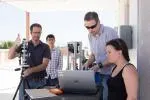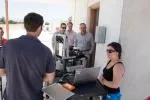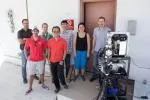Laser Demonstrates Robust Detection Capability at Distance on University of Arizona’s Rooftops



OSC Professor and PNNL Scientist Collaborate on Experiment to Create New Laser System that can Detect & Characterize Chemicals over large distances.
An innovative project is underway to develop experimental optical systems capable of detecting chemicals and compounds in the air we breathe using an invisible laser beam.
A team of Scientists, Faculty, and Students lead by Dr. Mark Phillips at the Pacific Northwest National Laboratory (PNNL) and Professor Jason Jones at the University of Arizona (UA) have combined intellectual forces and scientific resources after years of successful collaboration funded by the Department of Energy (Defense Nuclear Nonproliferation Research and Development) and Department of Defense (Defense Threat Reduction Agency).
In early May, both teams met on the roof of the College of Optical Sciences, to test out a PNNL custom-built External-Cavity Quantum Cascade Laser (ECQCL) by shooting an invisible and eye-safe laser across the University of Arizona Mall. The primary goal of the experiment was to test and characterize the ECQCL remote sensing system in “field” conditions.
The ECQCL was designed for rapid high-resolution infrared spectroscopy and sensing of gases. In other words, it quickly detects, identifies, and quantifies many different chemicals. The team also developed the software to analyze data in real time and can determine the make-up of any chemicals detected.
For this test, the ECQCL remote sensing system was placed on the rooftop of the College of Optical Sciences, and the output beam was directed to a mirror over 200 meters away. The light reflected off the mirror across the mall rooftops back to the equipment on the College of Optical Sciences roof. Then the specialized software designed by the team autonomously determined a variety of chemicals in the air over the UA Mall. They measured both naturally-occurring atmospheric gases as well as non-toxic tracer chemicals, such as Freons. A success!
Now that the ECQCL system, developed at PNNL, is shown to achieve both teams’ goals they have set themselves to develop a different laser that utilizes a broader spectrum, called “fs frequency combs.
This additional effort will allow the teams to compare two unique laser systems to in an attempt to garner a robust assessment of how both of these novel optical sensing techniques can improve the state of the art in spectroscopy. The teams hope to have the new laser source, designed by Professor Jones’ team, ready when Dr. Phillips returns to UA again and compare both systems.
These innovative methods of spectroscopy have the potential to revolutionize the remote sensing arena by allowing a large number of airborne chemical signatures to be detected and identified rapidly. The potential impacts of such technology have broad implications for many uses, including but not limited to stand-off detection, agricultural crop management, air-quality monitoring, oil and gas exploration and homeland security.
The University of Arizona College of Optical Sciences, founded as the Optical Sciences Center, has been shaping the future since 1964 by offering high-quality instruction, cutting-edge research and a solid commitment to the development of the optics industry. OSC remains dedicated to providing the state of Arizona and the nation with an internationally pre-eminent program in all aspects of the study of light. For more information, please visit www.optics.arizona.edu or call 520-621-6997.
Amee Hennig
Media Content Manager
520-626-4887
amee@optics.arizona.edu
